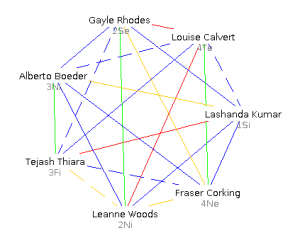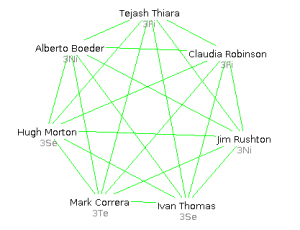Relationship Friction is a formula linking people’s behaviour and relationships to measures of financial performance.
Different Social Relationships require different levels of time, effort and energy in order to function at their best. By comparing the level of effort in a particular Social Relationship with both people's salaries, it is possible to show how much money is spent on Relationship Friction1. In turn, this allows the cost of relationships to be quantified in financial terms and linked to measures of performance such as metrics, revenues or costs.
An Example of Relationship Friction
In the table below, a random team of 7 is analysed using Relationship Friction2, 3. Everyone in the team is paid £50,000, making the total salary for the team £350,000. Given the 7 Social Profiles and the breakdown of the 21 Social Relationships, the cost of Relationship Friction for this team is £60,195 or 17.2% of the total team salary. In addition, the Relationship Friction Index is 864, allowing Relationship Friction data to be compared across different teams without revealing sensitive salary information.
| Name | Social Profile | Salary |
|---|---|---|
| Alberto Boeder | 3Ni | £50,000 |
| Fraser Corking | 4Ne | £50,000 |
| Gayle Rhodes | 2Se | £50,000 |
| Lashanda Kumar | 1Si | £50,000 |
| Leanne Woods | 2Ni | £50,000 |
| Louise Calvert | 4Te | £50,000 |
| Tejash Thiara | 3Fi | £50,000 |
| Total Salaries | £350,000 | |
| Relationship Friction | £60,195 | |
| Relationship Friction % | 17.2% | |
| Relationship Friction Index | 864 |
The table below shows the change in Relationship Friction if the team of 7 is optimised around a particular Social Group, in this case, Social Group 3. By creating a team in which everyone is a member of the same Social Group, not only does everyone experience optimal Social Relationships, but the Relationship Friction figures improve dramatically.
Relationship Friction falls to £18,357 or 5.2% of the team's combined salary. This is a difference in Relationship Friction of £41,838, or a fall of 12%. Likewise, the Relationship Friction index falls to 264.
| Name | Social Profile | Salary |
|---|---|---|
| Alberto Boeder | 3Ni | £50,000 |
| Claudia Robinson | 3Fi | £50,000 |
| Hugh Morton | 3Se | £50,000 |
| Ivan Thomas | 3Se | £50,000 |
| Jim Rushton | 3Ni | £50,000 |
| Mark Correra | 3Te | £50,000 |
| Tejash Thiara | 3Fi | £50,000 |
| Total Salaries | £350,000 | |
| Relationship Friction | £18,357 | |
| Relationship Friction % | 5.2% | |
| Relationship Friction Index | 264 |
Relationship Friction makes it possible to create more financially and operationally efficient environments for teams and individuals. In the case of teams, it is possible to manage team composition, reporting lines and overall organisational design against the backdrop of Relationship Friction and financial performance. From an individual perspective, lower Relationship Friction figures equate to higher levels of performance, engagement and well-being.
The data behind 4G and Relationship Friction has been empirically tested and is valid. For more information on the research behind 4G and Relationship Friction, please request a copy of the test manual.
Footnotes
1. While Relationship Friction calculations are typically expressed as costs, it should be noted that these costs are not quantifiable in the manner that an accountant would formally recognise. That said, Relationship Friction does offer a way to quantify the previously intangible which can then be analysed alongside other quantifiable measures.
2. To create the random team, a spreadsheet was used to simulate different combinations of Social Profiles. By way of context, having run the random team generator over 50 times, the average Relationship Friction % is calculated at 16.3% with a low of 12.3% and a high of 19.2%.
3. Work to date suggests that overall, teams typically have an average or normal distribution of Social Profiles and Social Relationships within them. There are some functional and industry biases (e.g. HR typically has more feeling profiles i.e. those with F in their acronym) but for the sake of this example, the random team presented is a good representation of what might be found if a team was picked at random from any organisation, regardless of seniority or function.






